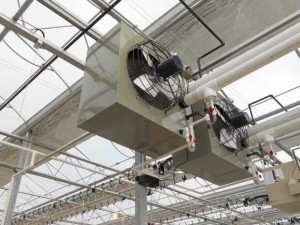New Ways To Give Growers Control Of The Greenhouse Environment

Growers are looking for low-cost options for temperature control, like circulating fans and exhaust fans.
Taming the weather is no easy task. Extreme conditions, however, are particularly problematic for growers who count on precise greenhouse environments to produce top-quality plants.
Luckily for today’s horticulture professionals, manufacturing companies continue to improve the equipment that allows growers to easily control the conditions in their greenhouses. Here’s what manufacturers have to say about the latest technology and how it helps streamline production.
Schaefer Ventilation Offers Efficiencies In Heating And Cooling
The most common thing growers need to control is temperature. Whether it’s heating the greenhouse after weeks of below-zero temperatures or cooling the potting area where employees are working during a particularly hot spring, growers spend a lot of time (and money) accounting for the highs and lows. Product manufacturers understand these concerns. The goal is to find new ways to alter the technology to meet growers’ individual needs.
Schaefer Ventilation provides ways for growers to be efficient by offering lines of horizontal airflow and evaporative cooling equipment.
“With our products, you can gain control over your environment, and get to the point where you’re not at the mercy of Mother Nature,” says market manager Brad D. Gaddy. “You can control your environment and maximize the way you can grow things. With respect to the air flow, you know your greenhouse is closed — that it’s not raining inside and spreading disease.”
One of the things Schaefer has noticed is that growers are starting to ask about more efficient ways of cooling the greenhouse. Although air conditioning is one option, Gaddy says most growers would prefer lower-cost options.
“We see that they’re asking for exhaust fans right now. Evaporative cooling is also coming back around a little bit,” he says. “Circulation fans are also great because they destratify the air mass, which makes the environment friendlier to grow plants in. We also see a trend of people requesting more efficient motors — more economical three-phase motors instead of single phase. Right now they’re really expensive, but you can control your speed and convert alternating current to direct current. It seems cost prohibitive to the grower right now, but people are looking to save money on utilities. We foresee a slow conversion to three-phase motors.”
Modine’s Focus On Product Longevity Saves Growers Money
In the spirit of efficiency, Modine Manufacturing Company focused its latest heating innovations on extending product life expectancy and lowering energy costs.
“We build to the demands of the horticultural market,” says Randy Mich, distributed products sales manager and a 30-year industry veteran. “Over the course of the 80s and 90s, greenhouses started to be buttoned up much more tightly, which meant raising the humidity and the amount of chemicals emitted from pesticides and other products inside the greenhouse. This was detrimental to the heating because traditionally, the heater would take air from inside the greenhouse, heat it up and send it back out. This shortened the life of the equipment.”
After seeing the life expectancy of its heaters drop from 20 to 25 years down to 10 to 15 years, Modine decided to develop separated combustion equipment that works similar to a home furnace: pulling air from outside the structure, heating it up, pushing it inside the structure.
“With the new equipment, life expectancy is projected to be 25 to 30 years,” Mich says. “This is really important to the business owner because heating is a grower’s second largest cost. But we weren’t satisfied.”
To help growers cut costs even more, the company introduced the Effinity93 line of products that boast 93 percent efficiency, which is a staggering improvement from the 80 percent and 65 percent efficient equipment produced in the past. This is especially exciting for growers who use savings to build their business.
“By upgrading to the high-efficiency line, growers are investing in their business by extending their growing seasons,” says Ray Schaffart, marketing and sales support manager. “Now they can take the savings, spend the same amount on energy and keep the greenhouse open for two more months.”
Modine is also looking into alternative energy sources, such as geothermal heating, to ensure its product lines continue to offer a variety of high-efficiency options.
Hurst Boiler Improves Efficiency with Biomass Options And Remote Technology
For Hurst Boiler, its biomass alternative energy products have allowed growers to reduce operational costs. While natural gas is the cheapest fuel out there right now, renewable energy gasification/thermal system sales manager Gene Zebley says using natural gas isn’t realistic for greenhouses set up far from natural gas lines, and the discounted prices won’t last.
“The greenhouse owners and growers who are managing for the life of their businesses, a lot of them have made the move toward biomass to hedge against when the natural gas prices go up again,” he says. “The ones that have already installed these boilers are the ones who claim the savings when the other gas prices go up.”
Hurst Boiler also improved boiler efficiency by patenting a boiler design that features an integrated economizer. Built directly into the boiler, the economizer improves the efficiency of the motor system. In terms of upcoming technology, Zebley says computer controls and software are the biggest advances. This allows growers to control their heating systems remotely. It also allows Hurst to log into the system and diagnose problems from afar, which saves the cost of deploying an on-site technician.
Bartlett’s Controllers Provide Growers With Flexibility And Peace-Of-Mind
Bartlett Instrument Co. is one company that understands the appeal of remote monitoring. In the controls business for more than 60 years and in the greenhouse controls business for 20, Bartlett offers a variety of environmental temperature controllers, relay boxes, wind and rain alarms and a communications system that allows growers to monitor the controllers from afar. When talking about these controls, marketing coordinator Megan Wagner echoes similar energy-focused priorities.
“Using a Bartlett controller, a grower can control a variety of equipment all in one convenient place,” she says. “It will also prevent heating and cooling appliances from running at the same time, which can happen when using thermostats. The controller keeps a very tight control over temperatures in the greenhouse.”
“A newly improved version of Bartlett’s communication system will release soon. It’s much easier for growers to make changes and monitor their greenhouses,” Wagner says. “It will now have the capability to send an email or text alert directly to your phone or computer. You can enter up to 30 different recipients, so everyone at the greenhouse can stay informed if there are any issues. It’s also got improved data logging. Data can be accessed in real time, directly in the program.”
If this sounds particularly innovative, growers can rest assured controls technology will only improve with time.
“With the trend toward technology,” Wagner says, “I can see people controlling entire greenhouse operations with just a few clicks on their smart phone










